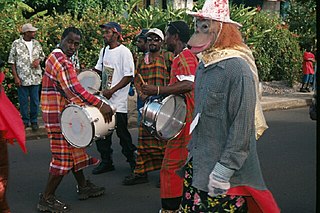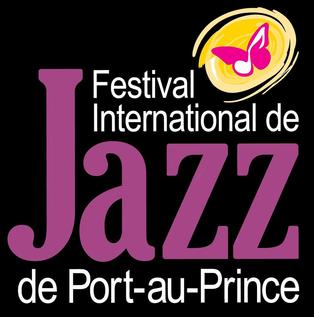Related Research Articles
The music of Latin America refers to music originating from Latin America, namely the Romance-speaking regions of the Americas. Latin American music also incorporates African music from enslaved African people who were transported from West and Central Africa to the Americas by European settlers, as well as music from the Indigenous peoples of the Americas. Due to its highly syncretic nature, Latin American music encompasses a wide variety of styles, including influential genres such as cumbia, bachata, bossa nova, merengue, rumba, salsa, samba, son, and tango. During the 20th century, many styles were influenced by the music of the United States giving rise to genres such as Latin pop, rock, jazz, hip hop, and reggaeton.
The music of Haiti combines a wide range of influences drawn from the many people who have settled on this Caribbean island. It reflects French, African rhythms, Spanish elements and others who have inhabited the island of Hispaniola and minor native Taino influences. Styles of music unique to the nation of Haiti include music derived from rara parading music, twoubadou ballads, mini-jazz rock bands, rasin movement, hip hop Creòle, the wildly popular compas, and méringue as its basic rhythm. Haiti hadn't had a recorded music until 1937 when Jazz Guignard was recorded non-commercially. One of the most current popular Haitian artists is Wyclef Jean. His music is somewhat hip hop mixed with worldbeat. Haitian music is influenced mostly by European colonial ties and African migration. In the case of European colonization, musical influence has derived primarily from the French.
The music of Martinique has a heritage which is intertwined with that of its sister island, Guadeloupe. Despite their small size, the islands have created a large popular music industry, which gained in international renown after the success of zouk music in the later 20th century. Zouk's popularity was particularly intense in France, where the genre became an important symbol of identity for Martinique and Guadeloupe. Zouk's origins are in the folk music of Martinique and Guadeloupe, especially Martinican chouval bwa, and Guadeloupan gwo ka. There's also notable influence of the pan-Caribbean calypso tradition and Haitian kompa.
The music of Guadeloupe encompasses a large popular music industry, which gained in international renown after the success of zouk music in the later 20th century. Zouk's popularity was particularly intense in France, where the genre became an important symbol of identity for Guadeloupe and Martinique. Zouk's origins are in the folk music of Guadeloupe and Martinique, especially Guadeloupan gwo ka and Martinican chouval bwa, and the pan-Caribbean calypso tradition.

The music of Dominica includes a variety of genres including all the popular genres of the world. Popular music is widespread, with a number of native Dominican performers gaining national fame in imported genres such as calypso, reggae, soca, kompa, zouk and rock and roll. Dominica's own popular music industry has created a form called bouyon, which combines elements from several styles and has achieved a wide fanbase in Dominica. Groups include WCK, Native musicians in various forms, such as reggae, kadans (Ophelia Marie, and calypso, have also become stars at home and abroad.

"La Dessalinienne" is the national anthem of Haiti. It was written by Justin Lhérisson and composed by Nicolas Geffrard.
Webert Sicot was a Haitian saxophone player, composer and band leader. He is recognized as one of the creators of compas also known as compas direct, a style of Haitian music born in the 1950s that he named cadence rampa after he left Nemours' band to differentiate himself in 1962 in the spirit of competition.
Black music is music created, produced, or inspired by black people, people of African descent, including African music traditions and African popular music as well as the music genres of the African diaspora, including Caribbean music, Latin music, Brazilian music and African-American music. These genres include spiritual, gospel, rumba, blues, bomba, rock and roll, rock, jazz, salsa, R&B, samba, calypso, soul, kwaito, cumbia, funk, ska, reggae, dub reggae, house, Detroit techno, amapiano, hip hop, pop, gqom, afrobeat, and others.
Charanga is a traditional ensemble that plays Cuban dance music. They made Cuban dance music popular in the 1940s and their music consisted of heavily son-influenced material, performed on European instruments such as violin and flute by a Charanga orchestra.. The style of music that is most associated with a Charanga is termed 'Danzón', and is an amalgam of both European classical music and African rhythms.
Compas is a modern méringue dance music of Haiti. The genre was popularized following the creation of Ensemble Aux Callebasses in (1955), which became Ensemble Nemours Jean-Baptiste In 1957. The frequent tours of the many Haitian bands have cemented the style in all the Caribbean. Therefore, compas is the main music of several countries such as Dominica and the French Antilles. Whether it is called zouk, where French Antilles artists of Martinique and Guadeloupe have taken it, or compas in places where Haitian artists have toured, this méringue style is influential in part of the Caribbean, Portugal, Cape Verde, France, part of Canada, South and North America.
Contradanza is the Spanish and Spanish-American version of the contradanse, which was an internationally popular style of music and dance in the 18th century, derived from the English country dance and adopted at the court of France. Contradanza was brought to America and there took on folkloric forms that still exist in Mexico, Venezuela, Colombia, Peru, Panama and Ecuador.
Mini-jazz is a reduced méringue-compas band format of the mid-1960s characterized by the rock band formula of two guitars, one bass, and drum-conga-cowbell; some use an alto sax or a full horn section, while others use a keyboard, accordion or lead guitar.
Rasin, also known as Haitian roots music, is a musical style that began in Haiti in the 1970s when musicians began combining elements of traditional Haitian Vodou ceremonial and folkloric music with various musical styles. The late 20th century style of this music links to the roots of Vodou tradition, where it came to be known as mizik rasin later in Haitian Creole. Modern-day, the movement is often referred to simply as "rasin" or "racine".
Méringue, also called méringue lente or méringue de salon, is a dance music and national symbol in Haiti. It is a string-based style played on the lute, guitar, horn section, piano, and other string instruments unlike the accordion-based merengue, and is generally sung in Haitian Creole and French, as well as in English and Spanish.
Jean Bélony Murat is a Haitian composer and guitarist. The songs in his first album Lakou trankil explain and reflect the problems Haitians face. BélO is popular in Europe and Africa where he won the Discovery RFI Prime in April 2006. This award had already helped other artists like Tiken Jah Fakoly and Rokia Traoré to reveal their talent in the music industry. BélO's musical approach is influenced by other Caribbean styles but mostly by reggae and jazz.
Number 9 Audio Group is a recording studio located in the Cabbagetown area of Toronto, Ontario, Canada at 222 Gerrard Street East. Number 9 produced the World Jazz For Haiti charity album in 2010, appeared on Much Music's DISBAND in 2008, and recorded Canadian acts Barenaked Ladies and Amanda Marshall in the 1990s, while they were still emerging artists.
Haitian rock, or rock kreyòl, started as rock n roll in Haiti in the early 1960s. It was played by rock bands called yeye bands. The name yeye derives from the Beatles lyrical verse, "yeah, yeah, yeah", which took off in the United States and was listened to by upper class Haitian families who had access to the radio. Young Haitians formed small electric guitar-based bands. These yeye rock bands were short-lived, as the addition of compas to their repertoires resulted in a sound was called mini-jazz, or mini-djaz in Haitian Creole.
Kontradans or the French-Haitian Contredanse, is creolized dance music formed in the 18th century in the French colony of Saint-Domingue (Haiti) that evolved from the English contra dance, or, which eventually spread throughout the Caribbean, Louisiana, Europe and the rest of the New World from the Creoles of Saint-Domingue.

The Port-au-Prince International Jazz Festival, also known as PAPJAZZ, is a large annual jazz festival held in Haiti, that features many well-known international jazz musicians, and emphasizes its insistence on true jazz, avoiding other forms of popular music. The event is held at various venues for eight nights. It is one of the largest festivals in the world, yielding thousands of visitors per year.
References
- ↑ Averill, Gage (1997). A Day for the Hunter, a Day for the Prey: Popular Music and Power in Haiti. p. 52. ISBN 0226032914 . Retrieved 20 April 2015.